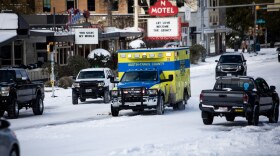Widespread power outages across the state have left millions of Texans without electricity. Some residents haven’t had power since Monday morning, as the region enters its second day of below-freezing temperatures.
Houston Public Media spoke with Dan Cohan, a professor of environmental engineering at Rice University, to learn more about what led to these widespread power outages and if they could have been prevented.
Read or listen to our interview with him below, edited for length and clarity.
Large swaths of Texas have experienced blackouts in the past day. Could you explain what led to these widespread power outages?
What’s happening now is that demand is at record highs as we’re trying to keep our homes warm in the coldest freeze that we’ve had in three decades. Demand for power right now is around 70 gigawatts and power plants in Texas right now can only supply about 45 gigawatts.
And so the system simply isn’t able to handle demand at the level it is, mostly because so many power plants are down right now. People are trying to keep their homes warm. Yet power plants aren’t able to operate the way they normally do both because they weren’t designed to operate well in freezing cold conditions and freezing rain conditions, and because many of the natural gas power plants aren’t able to get enough gas to burn.
Beyond the current conditions that are limiting operations and driving up demand, is there anything unique about Texas' energy infrastructure that has led us to this moment?
What makes it challenging to handle this is that we don’t have options that might give us more flexibility. We can’t import power from other states because we have so few lines connecting the Texas grid to our neighboring states. When it comes to electricity, what happens in Texas stays in Texas. Because Texas made a decision many decades ago to have its own power grid that wouldn’t connect to the rest of the country, in part because we didn’t want federal rules telling us the way Texas would handle things. And we’re paying the price for that now. Because just when we need the power most, we’re not able to import any of it from our neighboring states.
RELATED | Why Does Texas Have Its Own Power Grid?
Texas relies heavily on natural gas. But what about the other energy sources?
In general, the state gets around half of its power from natural gas, and around 20% from wind, around 20% from coal and most of the rest from nuclear. And usually it leads to pretty reliable power because usually wind and solar are able to generate as much as they can, and natural gas adjusts to be able to meet the ups and downs of wind and solar and of when we need power the most.
What’s happening now is what has traditionally been thought of as a viable source of power — natural gas — has been struggling. There’s record demand for natural gas, not just from power plants, but also from burning natural gas directly in our homes and offices.
Looking beyond right here, right now and keeping the bigger picture in mind, what can Texas do to prevent blackouts like this during cold weather weather events in the future?
There is no one silver bullet to keep this from happening again, we’re going to need a menu of options. We’re going to need to better insulate (and) weatherize our homes so that we can bring down the demand. We need to think about building some transmission lines to connect our isolated island with other states to be able to trade power. We need to have more storage on the grid — at the moment, there’s only a very tiny, tiny amount of power that can be stored in batteries.
And we need to be sure we’re maintaining a diversified supply, especially during daytime — now, solar panels are working great, but we don’t have many of them in the state. Having wind turbines in different parts of the state means that if we have icing conditions in some areas, then wind turbines can be operating well in others. So I wouldn’t say it’s an all-of-the-above approach, but it’s not going to be a single approach.
This article was originally published by Houston Public Media.






